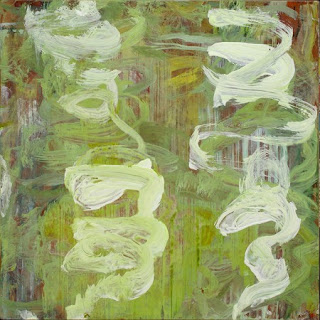For the past eight years the artist Chris Page has devoted himself to painting a sole subject: the stream. Page’s interest has been an ancient source of absorption. Most famously, the pre-Socratic philosopher Heraclitus used the stream as an exemplar for the endless flux among all phenomena: the quintessence of uncertainty. Page is fascinated with representing this flux and the uncertainty of the object.

Page’s work is characterized by organic tones, richly layered canvases, and whirling brushstrokes. On first observation, Page’s strategy for representing the stream is perplexing; the speed, transparency, and sharpness of stream movements are absent. Rather, his images are soft, dense, cloudlike, and slow. Page is not a realist, or for that matter a typical impressionist. Page does not seek mimesis in a classic sense; rather he seeks to represent the “essence” or soul of the stream. This is where Page makes his artistic contribution.
Page, like shamans, Zen painters and Chinese nature poets identifies with the “spirit” of the stream and in so doing, to then allow his body to channel that knowledge to express itself via paint on canvas. The process is similar to the automatism of abstract expressionists like Pollack and De Kooning. The difference is Page is not seeking to express his own subjectivity. Rather he attempts to become the object of his contemplation: the stream itself. In the tradition of mystical experience, he strives to dissolve the subject-object boundary. In this way he is an abstract “impressionist,” if you will, rendering his impression of the essence of a phenomenon, rather than expressing his subjectivity.
Page augments this channeling with another method: he renders his work like a palimpsest. Page repeatedly works a surface with paint, and then scrapes it away to render another interpretation. This process parallels how a stream, in its inexorable flow, can express itself in an infinite variety of ways as it covers the same surface in a streambed. This literal imitation of the repetition of sedimentation pays dividends for Page as the surfaces are richly textured and nuanced with many layers of shapes and colors that are deeply organic and ancient in appearance.

Another strategy Page employs to capture his mercurial subject is to break the boundaries of a single canvas to create triptychs depicting the stream at different points in time and space. In this way Page explores the identity of the stream as it utterly adapts to new contexts. He undoes the identity of a physical phenomenon in much the same way Pollock and De Kooning unraveled the notion of a stable subject.In these many paintings, one is struck by Page’s tenacity as he ignores the inherent resistance to representation by his subject. This frustration of cognition, and thus representation, is a “wound” that Page highlights as fundamental in our attempt to connect to world. He repeatedly tries to heal this gap in his work and in so doing reveals our need for profound resolution. Philosophically his work is reminiscent of the Buddhist notion of dukkha, or the fundamental "unsatisfactoriness" with our relation to the world: our deeper needs long for something that phenomena cannot offer. The soft dynamism of the Page’s composite paint strokes with their subtle energy and deeply organic tones summons a contemplative state from the viewer. Page’s work has the power to bring us to the depth of his investigations.

In his most recent work, Page pushes further to apprehend the nature of his subject. New work has us descending into the stream. The viewer feels small within these new paintings, enveloped by energy. Even at this level of abstraction, the colors in these works retain an uncanny fidelity to what we know as natural or earthy and organic. In this work I seem to nearly be intuiting the atomic level; the shape of the light reflected in the stream appears DNA-like in form. I struggle to articulate this depth and the odd familiarity with these images. It seems Page is pushing toward the articulation of archetypes in current work; viewing these pieces portends epiphany.
No comments:
Post a Comment